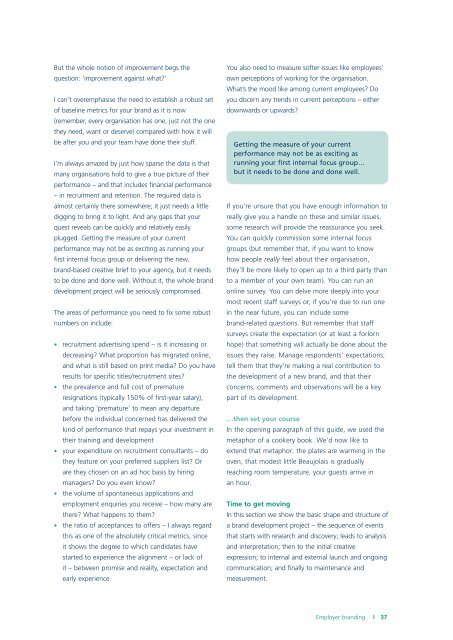Employer branding A no-nonsense approach - CIPD
Employer branding A no-nonsense approach - CIPD
Employer branding A no-nonsense approach - CIPD
You also want an ePaper? Increase the reach of your titles
YUMPU automatically turns print PDFs into web optimized ePapers that Google loves.
But the whole <strong>no</strong>tion of improvement begs the<br />
question: ‘improvement against what?’<br />
I can’t overemphasise the need to establish a robust set<br />
of baseline metrics for your brand as it is <strong>no</strong>w<br />
(remember, every organisation has one, just <strong>no</strong>t the one<br />
they need, want or deserve) compared with how it will<br />
be after you and your team have done their stuff.<br />
I’m always amazed by just how sparse the data is that<br />
many organisations hold to give a true picture of their<br />
performance – and that includes financial performance<br />
– in recruitment and retention. The required data is<br />
almost certainly there somewhere; it just needs a little<br />
digging to bring it to light. And any gaps that your<br />
quest reveals can be quickly and relatively easily<br />
plugged. Getting the measure of your current<br />
performance may <strong>no</strong>t be as exciting as running your<br />
first internal focus group or delivering the new,<br />
brand-based creative brief to your agency, but it needs<br />
to be done and done well. Without it, the whole brand<br />
development project will be seriously compromised.<br />
The areas of performance you need to fix some robust<br />
numbers on include:<br />
• recruitment advertising spend – is it increasing or<br />
decreasing? What proportion has migrated online,<br />
and what is still based on print media? Do you have<br />
results for specific titles/recruitment sites?<br />
• the prevalence and full cost of premature<br />
resignations (typically 150% of first-year salary),<br />
and taking ‘premature’ to mean any departure<br />
before the individual concerned has delivered the<br />
kind of performance that repays your investment in<br />
their training and development<br />
• your expenditure on recruitment consultants – do<br />
they feature on your preferred suppliers list? Or<br />
are they chosen on an ad hoc basis by hiring<br />
managers? Do you even k<strong>no</strong>w?<br />
• the volume of spontaneous applications and<br />
employment enquiries you receive – how many are<br />
there? What happens to them?<br />
• the ratio of acceptances to offers – I always regard<br />
this as one of the absolutely critical metrics, since<br />
it shows the degree to which candidates have<br />
started to experience the alignment – or lack of<br />
it – between promise and reality, expectation and<br />
early experience.<br />
You also need to measure softer issues like employees’<br />
own perceptions of working for the organisation.<br />
What’s the mood like among current employees? Do<br />
you discern any trends in current perceptions – either<br />
downwards or upwards?<br />
Getting the measure of your current<br />
performance may <strong>no</strong>t be as exciting as<br />
running your first internal focus group…<br />
but it needs to be done and done well.<br />
If you’re unsure that you have e<strong>no</strong>ugh information to<br />
really give you a handle on these and similar issues,<br />
some research will provide the reassurance you seek.<br />
You can quickly commission some internal focus<br />
groups (but remember that, if you want to k<strong>no</strong>w<br />
how people really feel about their organisation,<br />
they’ll be more likely to open up to a third party than<br />
to a member of your own team). You can run an<br />
online survey. You can delve more deeply into your<br />
most recent staff surveys or, if you’re due to run one<br />
in the near future, you can include some<br />
brand-related questions. But remember that staff<br />
surveys create the expectation (or at least a forlorn<br />
hope) that something will actually be done about the<br />
issues they raise. Manage respondents’ expectations;<br />
tell them that they’re making a real contribution to<br />
the development of a new brand, and that their<br />
concerns, comments and observations will be a key<br />
part of its development.<br />
…then set your course<br />
In the opening paragraph of this guide, we used the<br />
metaphor of a cookery book. We’d <strong>no</strong>w like to<br />
extend that metaphor: the plates are warming in the<br />
oven, that modest little Beaujolais is gradually<br />
reaching room temperature, your guests arrive in<br />
an hour.<br />
Time to get moving<br />
In this section we show the basic shape and structure of<br />
a brand development project – the sequence of events<br />
that starts with research and discovery; leads to analysis<br />
and interpretation; then to the initial creative<br />
expression; to internal and external launch and ongoing<br />
communication; and finally to maintenance and<br />
measurement.<br />
<strong>Employer</strong> <strong>branding</strong>

















